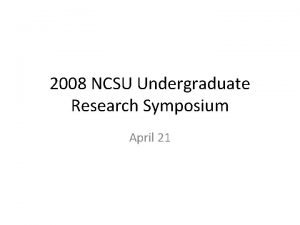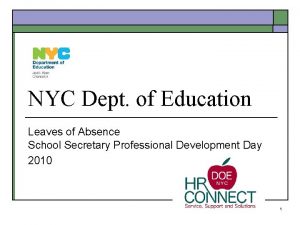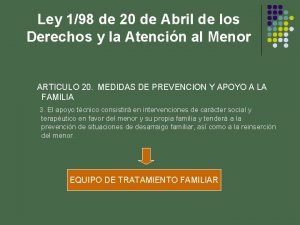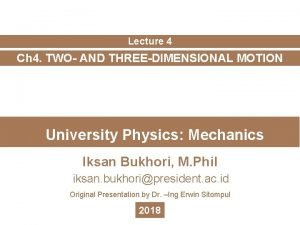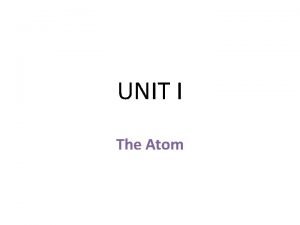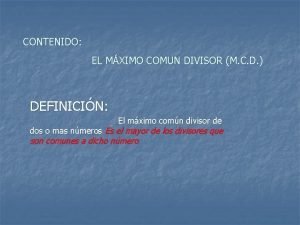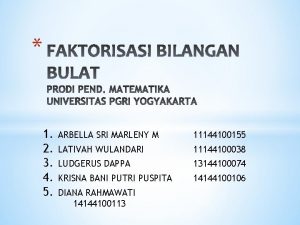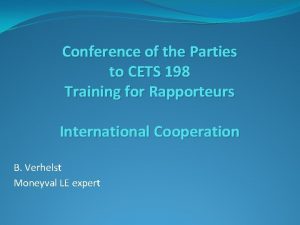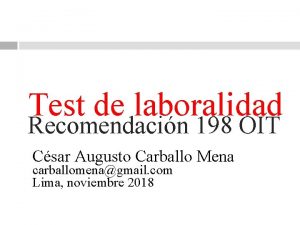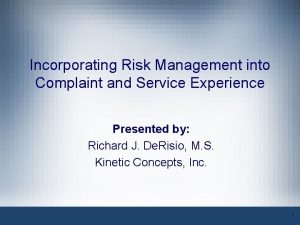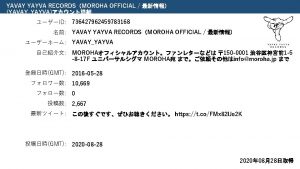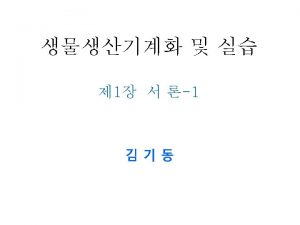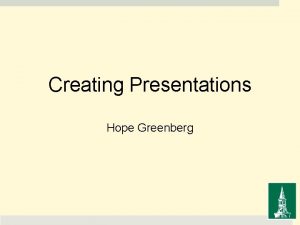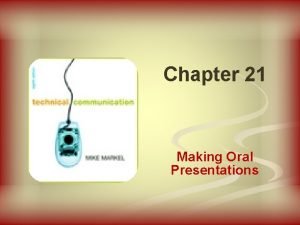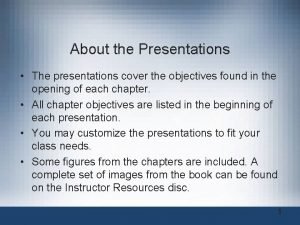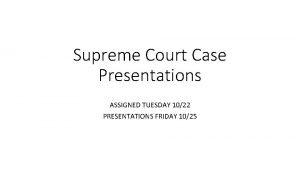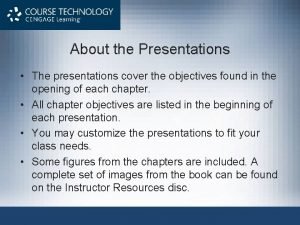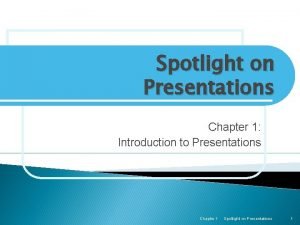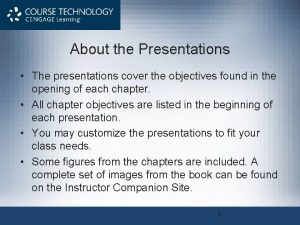Chem 198 Research Symposium Information on Presentations Chem


















- Slides: 18

Chem 198 Research Symposium Information on Presentations

Chem 198 Research Symposium • Friday, December 5, 3: 00 to 4: 30 at Sequoia 452 • Venue will allow oral presentations (tentatively 15 minutes); this will be followed by poster presentations in back • Prepare Presentation Titles – get to me by 11/26 – may want to discuss with your advisor

Chem 198 Research Symposium • Presentation Options – Poster (Single sheet, high quality poster) – 15 minute (may shorten if more than 2 presentations) Oral Presentation (use Powerpoint) • Selection Notes – Poster normally needs more time and must be finished in advance – An oral presentation needs you to practice to be able to do well • Please let me know by 11/24 of your presentation plans

Chem 198 Research Symposium • Poster Timeline – posters may be printed through CIMERA (not typically done for class projects, but they want to use up old printer suplies, posters needed by Wed, Nov. 26 or Monday, Dec. 1) – ASI may also pay for other poster printing, but quality is supposed to be lower – Send posters in PDF format (I hope to have email address up later) – Get your research advisor’s approval before submitting. – Start working on your poster early.

Chem 198 Research Symposium • Oral Presentations – suggest completing the slides at about the same time – practice talk several times, with adviser present at least once

Chem 198 Research Symposium • Schedule – 2: 50 to 3: 00 – set up posters – 3: 00 Introduction – 3: 05 to ~3: 35 Oral Presentations (can extend time/shorten talks if more than 2 oral presentations) – ~3: 40 to 4: 30 Poster Presentations

Making Your Poster • A visual presentation of your research. • Concise and focused (not a long presentation of your life’s work) • Explains your research using schematics, graphs, and other visual strategies, with a minimum of supporting text. • Uses various strategies to attract viewers and stimulate conversation.

Making Your Poster • Introduction/Summary: Concise background needed to understand the project and a statement of goals. • Methods: May shorten this section by using references for less critical techniques. Flow diagrams work well here. • Results and Discussion: Biggest section of the poster, with lots of graphs, figures, etc. Arrange in a logical order so conclusions naturally follow.

Making Your Poster • Conclusions: May use bulleted lists. This section should link clearly to your results. • Acknowledgements: collaborators and grant support. • References: Keep to a minimum. Only cite critical references to your project.

Making Your Poster • Open File > New Presentation • Format > Slide Layout > Title only • Open File > Page Set Up – Slide Sized for: Custom – Width 48 and Height 36 – Orientation (Slide) Landscape – Click OK • Note: You may get message “current page exceeds printable area of paper in printer. Say OK & ignore warning. You will not be printing full size on your desktop printer.

Making Your Poster • Should be able to read anything from 4’- 6’ away. • Establish a hierarchy of importance using the font size: – Title: 65 -108 pts – Subheadings: 36 -54 pts – Body text: 18 -27 pts • • Avoid script fonts & ALL CAPS. Use a light-colored background. ** Check your spelling. Check areas both at Zoom = 100% (e. g. to check for pixelation) and at 15% to look at whole poster

Making Your Poster Full View to Look at Organization 100% view to check for pixelation, sizing

Making Your Poster • Keep text presentation neat & uncluttered: – Indent to set text apart or to make short lists – Left justify to make it easier to read – Use line spacing & paragraph spacing to balance text • Graphics communicate concepts quickly • Graphs should be viewable from 4’ - 6’: – – Label within graphs or charts (rather than keys) Add titles Y-axis labels aligned horizontally are easier to read Avoid colored backgrounds, gridlines, etc.

Making Your Poster • Graphs & Charts: – Make sure that the text on axes and legends adhere to the minimum font size. – Few lines on a graph - label directly. – Multiple lines on a graph - use a legend. – Try to make all graphs and figures the same size for consistency. – Make lines in the graphs thick enough to see from 4’- 6’ away. • Pictures: – Use images 300 dpi (avoid pixelation when enlarged). – Be careful with images from internet or captured from screen.

Making Your Poster • Tips: – Try to achieve balance of content & presentation – Type text into Word; create graphs in Excel; draw structures in Chem. Draw (and then paste into Power. Point). – Plan layout on paper before using Power. Point. – Remember to Save your work. . Frequently.

Making Your Poster • Print a small version for feedback: – Use the Scale to Fit option in your printing dialog box. – If you can’t read on 8. 5 x 11 page, the text is probably too small. • Proofread all aspects of poster: – Make corrections or additions. – Redo areas that are unclear.

Acknowledgments • Much of the material for this presentation was borrowed from Dr. Ben Gherman • I plan to post this presenation on the Chem 198 website

Making Your Poster
 Ncsu undergraduate research symposium
Ncsu undergraduate research symposium Solar year 198
Solar year 198 Doe restoration of health leave
Doe restoration of health leave Ley 198
Ley 198 Jesus o bom amigo harpa cristã
Jesus o bom amigo harpa cristã A rescue plane flies at 198 km/h
A rescue plane flies at 198 km/h Bill 198 sox
Bill 198 sox Au-197=50 au 198=50
Au-197=50 au 198=50 Mcd 90 126
Mcd 90 126 Au-197=50 au 198=50
Au-197=50 au 198=50 Fpb dari 198
Fpb dari 198 A rescue plane flies at 198 km/h
A rescue plane flies at 198 km/h Cets 198
Cets 198 Test de laboralidad oit
Test de laboralidad oit 十字架永是我的榮耀
十字架永是我的榮耀 21cfr820.198
21cfr820.198 Le duet 198
Le duet 198 198 2
198 2 Craft of scientific presentations
Craft of scientific presentations
